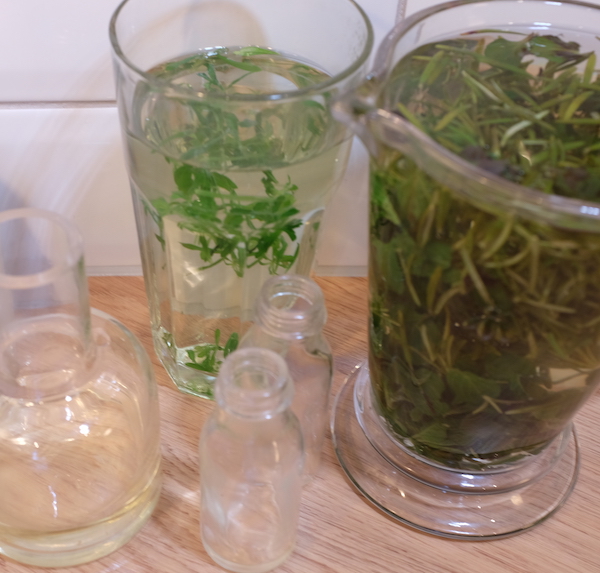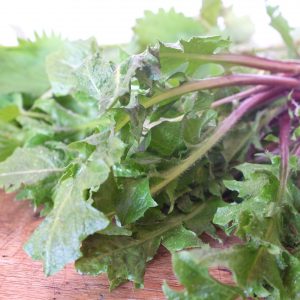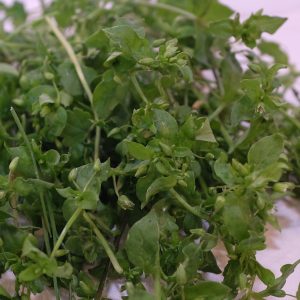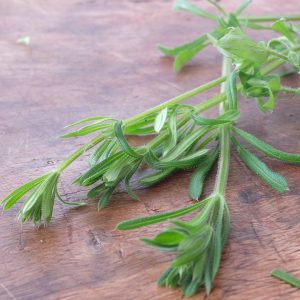
This is an article published recently by Permaculture Magazine.
‘Weed’ is a controversial term. I feel slanderous using it. Every definition I can find references weeds as either unwanted or feeble. At best they are misplaced. (Curious that the same word can be used as a derogatory term for something that is either too vigorous, or too weak).
The wily weeds
There’s a ditty I learnt as a child called ‘The Wily Weeds’ that gives the impression of weeds as a troublesome thing that we should strive to dispose of, though they always get the better of us.
The Wily Weeds
by Mary W McClure
‘I have a little garden and
I dig it every day;
I water all the pretty flowers
and throw the weeds away.
And yet, tho’ flowers are very scarce,
Of weeds there is no lack;
For when I’m fast asleep in bed,
They all come creeping back.
And this is most annoying for,
As anyone can tell,
They never come back by themselves –
They bring their friends as well.’
I’ve grown up to be a believer in using the resources we have around us. It seems unfortunate that so much effort goes into ridding ourselves of ‘weeds’ instead of recognising the valuable resource they represent. Knowing that nature provides what is needed in the right place, at the right time, it’s possible to believe that ‘weeds’ are with us for a reason.
A name you can trust
In the ancient past when these plants were being given their common names – a means to recognise their properties and share information – a culinary or medicinal reference would often be made. The term ‘physician’ has its origins in the latin ‘physica’ meaning: things relating to nature. Many names will reference the therapeutic properties of the plant: such as Knitbone (comfrey), Staunchweed (yarrow) or the self-explanatory Feverfew and Nipplewort (both of the generous Compositae family of plants). Other plants have their culinary properties singled out: Hairy Bittercress wouldn’t be picked for meal; anything with the word ‘sorrel’ means ‘sour’ e.g., Wood Sorrel; Garlic Mustard, also known as ‘Sauce-alone’ is clearly a sharp accompaniment to a meal, and so on.
This tells us that traditionally plants have been thought of more for their use than their appearance. The cultivation of decorative flower gardens is a relatively recent pre-occupation in the history of plant use and appreciation
Native skincare
In seeking plants to use in natural skincare I go first to what grows around us. These plants have experienced the same climatic conditions as us, the same seasons and the same soils. It would not be surprising for our native plants to have more affinity with our skin than ingredients from tropical grown plants, used to year-round sun and unaccustomed to our grey drizzle.
The enchantment of the exotic is often just that – captivating but potentially beguiling. Take something out of context and it rarely has the same level of romance or utility that it offers in its native home.
In contrast, it is magical to find plants growing in abundance around us that actually have helpful properties that we can deploy. Yes, abundance-and-utility is only found in a subset of plants, but there are few that are really worth knowing. And, because they grow in such abundance, we can happily gather them for use in small doses, without degrading the environment.
My purpose in sourcing plants is traditional and utilitarian, more related to the ‘folk medicine cabinet’ of the hedgerow than the decorativeness of a flower garden. For me skincare is not primarily concerned with ‘beauty’ or ‘pampering’ but health and wellbeing, recognising the skin as the largest organ of the body – protector and indicator of our internal fitness. I see listening to and supporting our skin and its natural processes as a key to living healthily. Which, of course, has its own intrinsic beauty.
My top 5 ‘weeds’ that I wouldn’t be without
With a love of function and abundance, I’m happy to say that these top 5 ‘weeds’ are commonplace in my garden, and a welcome sight. They are
-
DANDELION – Taraxacum officinale
A member of the Compositae family (the daisies), dandelion is a cousin to calendula, a much-revered skincare ingredient in blend-it-yourself and commercial applications. Dandelion has long been used in a medicinal context in European folk, native American and Chinese traditions. In skincare applications dandelion-infused oils can soothe irritations and nourish dry skin. It is therefore helpful in moisturisers, lip balms, salves for burns and bites, and for creams to tackle rashes or cracked and dry skin.
With a reputation for brightening dull skin, a simple dandelion skin tonic can be a pick-me-up that is easy to make at any time.
DANDELION SKIN TONIC
A generous handful of dandelion leaves.
2 heaped tablespoons of fresh thyme leaves (or 1 tbsp dried thyme leaves)
1 teaspoon of witch hazel
MAKE: Put the herbs in a bowl and pour over 300ml of boiling water.
Leave to infuse for 20 minutes then strain through a sieve.
Add the witch hazel. Bottle and shake well.
USE: Apply this to your face in the morning as a refreshing wake-up for the skin, or in the evening to sweep away the last traces of cleanser.
STORE: Keep in the fridge and use within 2-3 days. You can also freeze supplies as ice cubes and bring out to defrost when needed.
It is not unusual for scientific investigations to substantiate long-held folk traditions. In the case of dandelions, modern studies support the use of flower and leaf extracts in skincare, particularly citing the benefit of supporting the skin against the ageing processes brought about by UVB exposure.
Ref: https://www.hindawi.com/journals/omcl/2015/619560/
-
PLANTAIN – Plantago major
Plantains can be an indicator of human interaction with place. Their common name ‘white man’s foot’ alludes to the seeds being spread worldwide during colonial times in the trouser turn-ups of Europeans. They offer a sense of endurance with their habit of continuing to live even when stood on and crushed. This led to a sympathetic belief that the plant would help heal crushing, tearing and bruising of the skin.
Plantain has long been relied on for its medicinal properties. The Greek physician Discorides advised that the plantain should be applied externally to all kinds of sores and it was revered as one of the Anglo Saxon 9 sacred herbs. Traditions recommend using the underside of the leaf to draw a wound (bring out any pus) and then the smoother, upper side to complete the healing (often moistening first with spit).
For skincare, plantain has a cooling and soothing effect. It is therefore very useful for treating eczema, burns and scalds. It can also be applied to wounds, insect bites and eye inflammations.
-
CHICKWEED – Stellaria media
Wherever you are, you should find chickweed not too far away. It grows on every continent with the exception of the most Artic regions. It’s in bloom most of the year round, although its tiny white star-like flowers are easily missed.
Chickweed is best used fresh, which is why you’ll rarely find it in commercial skincare, even though it’s a lovely soothing herb. Culpeper considered chickweed ‘a fine, soft, pleasing herb … the herb bruised or the juice applied (with cloths or sponges dipped therein) is effectual for all redness in the face, wheals, pushes, itch, scabs.’
Chickweed comes into its own when tackling irritation and allergies or the itchiness that accompanies rashes and eczema. It has a double action on these with demulcants to provide a protective, moisturising film while saponins soothingly ease the itch. It’s also praised as an addition to the bath for treating the pain of rheumatism
To benefit from chickweed you can add an infusion to your bath, create a bodywash by boiling a handful in about 2.5 litres of water for ten minutes, or apply an ointment made with oil macerated with chickweed. You can also try soothing sore eyes with an infusion. Make this by filling a smallmuslin bag with chickweed then plunging it into boiling water for two minutes. Once cooled it can be placed on the eyelids to soothe.
Chickweed requires very little effort to gather, and you only need collect that which you will use immediately so it’s well worth seeking out and dedicating a few minutes to.
CHICKWEED OINTMENT
3 tbsp chickweed, chopped
1 tbsp (15ml) sunflower oil
1 tsp (5g) beeswax
1 tsp (5g) walnut butter
MAKE: Put the chickweed into a clean jar and pour over the sunflower oil, ensuring the herb is entirely submerged. Seal the jar and place on a sunny windowsill. Each day gently rock the jar to agitate your blend. After three to six weeks, strain off the herb through a muslin. Add the strained oil to the beeswax and butter in the top of a double boiler (bain marie) and heat until the beeswax melts, stirring all the while. Transfer to over a bowl of cold water and keep stirring until the ointment cools. Transfer to a clean pot, label and seal
USE: Rub the ointment into the affected area as needed, repeating regularly.
STORE: Keep sealed in a cool, dark place. It should keep for 12 months.
-
CLEAVERS – Galium aparine
There are so many common names for cleavers it’s clear it has long been a ubiquitous plant. Most of them make some kind of reference to the clinging nature of the plant and its tiny seeds that disperse themselves by means of hitching a lift on any passing person or livestock. Perhaps one of the more irritating of ‘weeds’.
Cleavers has traditionally been considered one of the spring depurative herbs – a collection of plants that are particularly good deployed as tonics for cleansing and refreshing. Scientific study has identified three distinct acids in cleavers that can support the skin: tannic, citric and rubichloric. Tannins are antioxidant and so help protect against free radical damage (that contributes to ageing). Citric acid, in small quantities, can help exfoliation (the natural shedding of dead skin cells) creating more even and fresher looking skin.
Cleavers can helpfully be used as a facewash to clear the complexion or as a hair tonic to improve texture and shine. It can be soothing for eczema and psoriasis as well as used in treating minor cuts and scratches, sunburn or scalds and burns. It’s also possible to make an effective deodorant incorporating cleavers. There’s more about natural deodorants in my blog at www.fieldfreshskincare.co.uk/blog
As with chickweed, it’s best to use cleavers fresh, so pick as you need it.
-
NETTLES – Urtica dioica
Most of us have experienced the tingling sting of a nettle so it may be some surprise to know it’s actually a great herb for skincare.
So often found among rubbish, at waste sites and compost heaps, it’s a weed most would like to avoid in their gardens. Their presence is most often a result of disturbing the ground and the tenacity of nettles to find the richest soils. The presence of nettles is a good indicator of fertility: be glad. (But a quick warning as an aside, in Denmark nettles are said to mark the dwelling place of elves).
I’m not recommending applying nettles directly to the skin – although this was done by Roman soldiers trying to ward off the British cold. Nettles are best gathered with care and then macerated in oils or infused to create your skincare products.
As with gathering nettles for fortifying soups, select the top-most leaves for your skincare. It’s best to use dry plant material in a maceration to avoid introducing water which could create mould and render it unusable. Once you’ve created your nettle oil, use it directly or combine it into creams and balms. It’s a useful ally against inflamed psoriasis.
Nettles have a great reputation as a hair tonic. You can use an infusion of the leaves to condition hair. I’m currently experimenting with using nettles in shampoo bars, you can follow my progress on Instagram, @fieldfreshskincare.
NETTLE HAIR TONIC
A handful of nettles
MAKE: Put the nettles into a pan and cover with 1 litre of water. Bring to the boil and then simmer for 2 hours. Leave to cool, then strain and bottle.
USE: Saturate the scalp with the lotion every other night, leaving for half an hour before shampooing.
STORE: Keep in the fridge, it will last for a week.
Wonderful weeds
Five is just the start, I could continue listing and describing the wonderful properties of many vibrant plants that are often dismissed as weeds. Their very ability to exist and vigorously proceed, despite our attempts to eliminate them, are surely indicators of the vitality they contain.
I’m sure you won’t fail to stumble upon some of these, and maybe look at them with new eyes. They have plenty to offer you. Just as old utensils become a thing of beauty, so our old hedgerow friends can hold a charm of their own which is none the less for being common.
Forage sustainably
Some guidance for sympathetic and successful foraging:
- Source your plants a little off the beaten track, away from vehicle pollution or urinating animals
- Always leave more than you take
- Do not harvest roots, unless with special permission from the landowner
- Seek the best examples of leaves and flowers, especially for skincare, leave behind those that are blemished or damaged.







[…] as you build your repertoire of skincare ingredients, here’s another five that you may find in your garden (whether you want them there or […]
Yeah, the leaf does look familiarity with a couple of plants, anyways the poem is super good, thanks for sharing 🙂